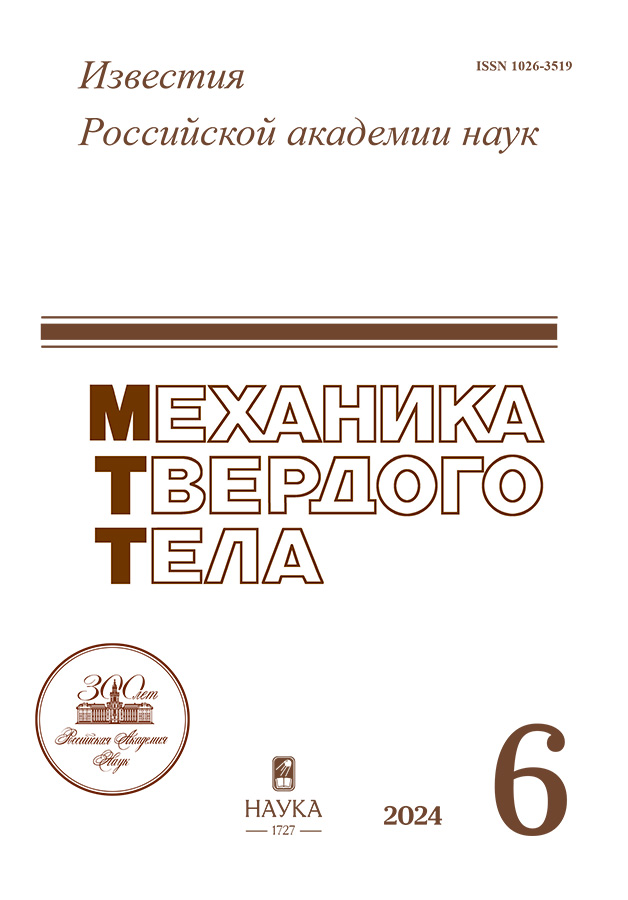Features of the dynamics of a rotating shaft with nonlinear models of internal damping and elasticity
- 作者: Azarov А.А.1, Gouskov A.М.1,2, Panovko G.Y.2
-
隶属关系:
- Bauman Moscow State Technical University
- Mechanical Engineering Research Institute of RAN
- 期: 编号 6 (2024)
- 页面: 74-90
- 栏目: Articles
- URL: https://rjmseer.com/1026-3519/article/view/682271
- DOI: https://doi.org/10.31857/S1026351924060043
- EDN: https://elibrary.ru/TZDRLI
- ID: 682271
如何引用文章
详细
The paper analyzes the influence of nonlinear (cubic) internal damping (in the Kelvin–Feucht model) and cubic nonlinearity of elastic forces on the dynamics of a rotating flexible shaft with a distributed mass. The shaft is modeled by a Bernoulli–Euler rod using the Green function, the discretization and reduction of the problem of rotating shaft dynamics to an integral equation are performed. It is revealed that in such a system there is always a branch of limited periodic movements (self-oscillations) at a supercritical rotation speed. In addition, with low internal damping, the periodic branch continues into the subcritical region: when the critical velocity is reached, the subcritical Poincare–Andronov–Hopf bifurcation is realized and there is an unstable branch of periodic movements, below the branch of stable periodic self-oscillations (the occurrence of hysteresis with a change in rotation speed). With an increase in the internal friction coefficient, the hysteresis phenomenon disappears and at a critical rotation speed, a soft excitation of self-oscillations of the rotating shaft occurs through the supercritical Poincare–Andronov–Hopf bifurcation.
全文:
作者简介
А. Azarov
Bauman Moscow State Technical University
编辑信件的主要联系方式.
Email: 13azarov.ru@gmail.com
俄罗斯联邦, Moscow
A. Gouskov
Bauman Moscow State Technical University; Mechanical Engineering Research Institute of RAN
Email: gouskov_am@mail.ru
俄罗斯联邦, Moscow; Moscow
G. Panovko
Mechanical Engineering Research Institute of RAN
Email: gpanovko@yandex.ru
俄罗斯联邦, Moscow
参考
- Bolotin V. Nonconservative problems of the theory of elastic stability. M.: Nauka, 1961 (in Russian).
- Ding Q., Cooper J., Leung A. Hopf bifurcation analysis of a rotor/seal system // J. Sound Vibr. 2002. V. 252. № 5. P. 817–833. https://doi.org/10.1006/jsvi.2001.3711
- Karpenko E.V., Pavlovskaia E.E. Bifurcation analysis of a preloaded Jeffcott rotor // Chaos, Sol. Fract. 2003. V. 15. № 2. P. 407–416. https://doi.org/10.1016/S0960-0779(02)00107-8
- Ehrich F. Observations of subcritical, superharmonic and chaotic response in rotor dynamics // Vibr. Acous. 1992. № 114. P. 93–114. https://doi.org/10.1115/1.2930240
- Kimpbal A. Internal friction as a cause of shaft whirling // Phil. Mag. 1925. V. 49. P. 724–727.
- Newkirk B.L. Saft wipping // General Electric Rev. 1924. V. 27. № 3. P. 169–178.
- Genta G. et al. Vibration dynamics and control. NY: Springer, 2009.
- Li Y. et al. Dynamic modelling and vibration analysis of a bolted spigot joint structure considering mating interface friction: simulation and experiment // Nonlinear Dynamics. 2024. P. 1–24. https://doi.org/10.1007/s11071-024-09365-6
- Schwarz U. Continuum mechanics / Heilenberg University, 2023. URL: https://www.thphys.uni-heidelberg.de/~biophys/PDF/Skripte/Script_Continuum_Mechanics.pdf (date of application 01.04.2024).
- Lewandowski R., Chorążyczewski B. Identification of the parameters of the Kelvin–Voigt and the Maxwell fractional models, used to modeling of viscoelastic dampers // Computers & Structures. 2010. V. 88. № 1–2. P. 1–17.
- Hetzler H., Boy F. Internal dissipation and self-excited ocillations in rotating machinery: internal friction vs. internal viscous damping // International Symposium on Transport Phenomena and Dynamics of Rotating Machinery (ISROMAC 2017). 2017.
- Azarov A.A., Gouscov A.M., Panovko G.Y. Dynamics of a flexible disk rotor under a point contact with discrete viscoelastic oscillation limiters // J. Mach. Manufac. Reliability. 2023. № 1. P. 26–37. https://doi.org/10.31857/S0235711923010029
- Panovko Y.G. Internal friction in oscillations of elastic systems. M.: Fizmatgiz, 1960 (in Russian).
- Svetlitsky V.A. Mechanics of rods. M.: Vyshaya Shkola, 1987 (in Russian).
补充文件

















